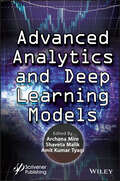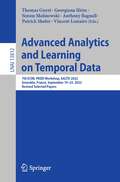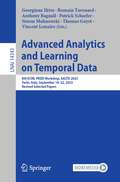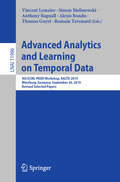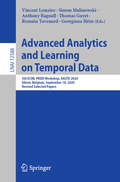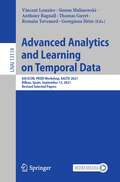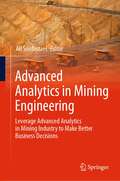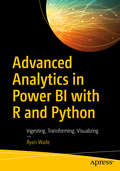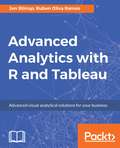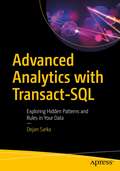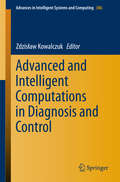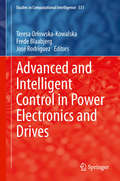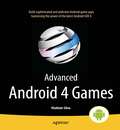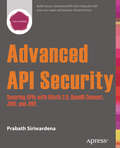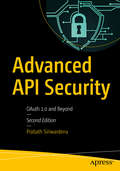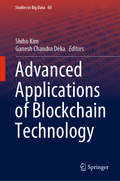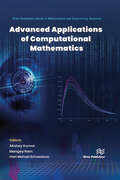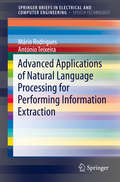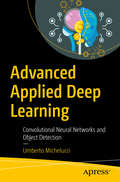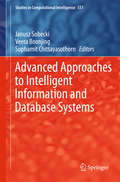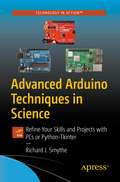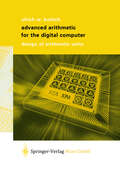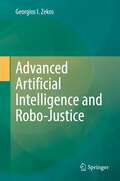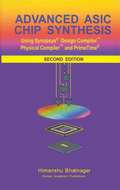- Table View
- List View
Advanced Analytics and Deep Learning Models (Next Generation Computing and Communication Engineering)
by Archana Mire Shaveta Malik Amit Kumar TyagiAdvanced Analytics and Deep Learning Models The book provides readers with an in-depth understanding of concepts and technologies related to the importance of analytics and deep learning in many useful real-world applications such as e-healthcare, transportation, agriculture, stock market, etc. Advanced analytics is a mixture of machine learning, artificial intelligence, graphs, text mining, data mining, semantic analysis. It is an approach to data analysis. Beyond the traditional business intelligence, it is a semi and autonomous analysis of data by using different techniques and tools. However, deep learning and data analysis both are high centers of data science. Almost all the private and public organizations collect heavy amounts of data, i.e., domain-specific data. Many small/large companies are exploring large amounts of data for existing and future technology. Deep learning is also exploring large amounts of unsupervised data making it beneficial and effective for big data. Deep learning can be used to deal with all kinds of problems and challenges that include collecting unlabeled and uncategorized raw data, extracting complex patterns from a large amount of data, retrieving fast information, tagging data, etc. This book contains 16 chapters on artificial intelligence, machine learning, deep learning, and their uses in many useful sectors like stock market prediction, a recommendation system for better service selection, e-healthcare, telemedicine, transportation. There are also chapters on innovations and future opportunities with fog computing/cloud computing and artificial intelligence. Audience Researchers in artificial intelligence, big data, computer science, and electronic engineering, as well as industry engineers in healthcare, telemedicine, transportation, and the financial sector. The book will also be a great source for software engineers and advanced students who are beginners in the field of advanced analytics in deep learning.
Advanced Analytics and Learning on Temporal Data: 7th ECML PKDD Workshop, AALTD 2022, Grenoble, France, September 19–23, 2022, Revised Selected Papers (Lecture Notes in Computer Science #13812)
by Thomas Guyet Georgiana Ifrim Simon Malinowski Anthony Bagnall Patrick Shafer Vincent LemaireThis book constitutes the refereed proceedings of the 7th ECML PKDD Workshop, AALTD 2022, held in Grenoble, France, during September 19–23, 2022.The 12 full papers included in this book were carefully reviewed and selected from 21 submissions. They were organized in topical sections as follows: Oral presentation and poster presentation.
Advanced Analytics and Learning on Temporal Data: 8th ECML PKDD Workshop, AALTD 2023, Turin, Italy, September 18–22, 2023, Revised Selected Papers (Lecture Notes in Computer Science #14343)
by Georgiana Ifrim Romain Tavenard Anthony Bagnall Patrick Schaefer Simon Malinowski Thomas Guyet Vincent LemaireThis volume LNCS 14343 constitutes the refereed proceedings of the 8th ECML PKDD Workshop, AALTD 2023, in Turin, Italy, in September 2023. The 20 full papers were carefully reviewed and selected from 28 submissions. They are organized in the following topical section as follows: Machine Learning; Data Mining; Pattern Analysis; Statistics to Share their Challenges and Advances in Temporal Data Analysis.
Advanced Analytics and Learning on Temporal Data: 4th ECML PKDD Workshop, AALTD 2019, Würzburg, Germany, September 20, 2019, Revised Selected Papers (Lecture Notes in Computer Science #11986)
by Vincent Lemaire Simon Malinowski Anthony Bagnall Alexis Bondu Thomas Guyet Romain TavenardThis book constitutes the refereed proceedings of the 4th ECML PKDD Workshop on Advanced Analytics and Learning on Temporal Data, AALTD 2019, held in Würzburg, Germany, in September 2019. The 7 full papers presented together with 9 poster papers were carefully reviewed and selected from 31 submissions. The papers cover topics such as temporal data clustering; classification of univariate and multivariate time series; early classification of temporal data; deep learning and learning representations for temporal data; modeling temporal dependencies; advanced forecasting and prediction models; space-temporal statistical analysis; functional data analysis methods; temporal data streams; interpretable time-series analysis methods; dimensionality reduction, sparsity, algorithmic complexity and big data challenge; and bio-informatics, medical, energy consumption, on temporal data.
Advanced Analytics and Learning on Temporal Data: 5th ECML PKDD Workshop, AALTD 2020, Ghent, Belgium, September 18, 2020, Revised Selected Papers (Lecture Notes in Computer Science #12588)
by Vincent Lemaire Simon Malinowski Anthony Bagnall Thomas Guyet Romain Tavenard Georgiana IfrimThis book constitutes the refereed proceedings of the 4th ECML PKDD Workshop on Advanced Analytics and Learning on Temporal Data, AALTD 2019, held in Ghent, Belgium, in September 2020. The 15 full papers presented in this book were carefully reviewed and selected from 29 submissions. The selected papers are devoted to topics such as Temporal Data Clustering; Classification of Univariate and Multivariate Time Series; Early Classification of Temporal Data; Deep Learning and Learning Representations for Temporal Data; Modeling Temporal Dependencies; Advanced Forecasting and Prediction Models; Space-Temporal Statistical Analysis; Functional Data Analysis Methods; Temporal Data Streams; Interpretable Time-Series Analysis Methods; Dimensionality Reduction, Sparsity, Algorithmic Complexity and Big Data Challenge; and Bio-Informatics, Medical, Energy Consumption, Temporal Data.
Advanced Analytics and Learning on Temporal Data: 6th ECML PKDD Workshop, AALTD 2021, Bilbao, Spain, September 13, 2021, Revised Selected Papers (Lecture Notes in Computer Science #13114)
by Vincent Lemaire Simon Malinowski Anthony Bagnall Thomas Guyet Romain Tavenard Georgiana IfrimThis book constitutes the refereed proceedings of the 6th ECML PKDD Workshop on Advanced Analytics and Learning on Temporal Data, AALTD 2021, held during September 13-17, 2021. The workshop was planned to take place in Bilbao, Spain, but was held virtually due to the COVID-19 pandemic. The 12 full papers presented in this book were carefully reviewed and selected from 21 submissions. They focus on the following topics: Temporal Data Clustering; Classification of Univariate and Multivariate Time Series; Multivariate Time Series Co-clustering; Efficient Event Detection; Modeling Temporal Dependencies; Advanced Forecasting and Prediction Models; Cluster-based Forecasting; Explanation Methods for Time Series Classification; Multimodal Meta-Learning for Time Series Regression; and Multivariate Time Series Anomaly Detection.
Advanced Analytics in Mining Engineering: Leverage Advanced Analytics in Mining Industry to Make Better Business Decisions
by Ali SoofastaeiIn this book, Dr. Soofastaei and his colleagues reveal how all mining managers can effectively deploy advanced analytics in their day-to-day operations- one business decision at a time.Most mining companies have a massive amount of data at their disposal. However, they cannot use the stored data in any meaningful way. The powerful new business tool-advanced analytics enables many mining companies to aggressively leverage their data in key business decisions and processes with impressive results.From statistical analysis to machine learning and artificial intelligence, the authors show how many analytical tools can improve decisions about everything in the mine value chain, from exploration to marketing.Combining the science of advanced analytics with the mining industrial business solutions, introduce the “Advanced Analytics in Mining Engineering Book” as a practical road map and tools for unleashing the potential buried in your company’s data.The book is aimed at providing mining executives, managers, and research and development teams with an understanding of the business value and applicability of different analytic approaches and helping data analytics leads by giving them a business framework in which to assess the value, cost, and risk of potential analytical solutions. In addition, the book will provide the next generation of miners – undergraduate and graduate IT and mining engineering students – with an understanding of data analytics applied to the mining industry. By providing a book with chapters structured in line with the mining value chain, we will provide a clear, enterprise-level view of where and how advanced data analytics can best be applied. This book highlights the potential to interconnect activities in the mining enterprise better. Furthermore, the book explores the opportunities for optimization and increased productivity offered by better interoperability along the mining value chain – in line with the emerging vision of creating a digital mine with much-enhanced capabilities for modeling, simulation, and the use of digital twins – in line with leading “digital” industries.
Advanced Analytics in Power BI with R and Python: Ingesting, Transforming, Visualizing
by Ryan WadeThis easy-to-follow guide provides R and Python recipes to help you learn and apply the top languages in the field of data analytics to your work in Microsoft Power BI. Data analytics expert and author Ryan Wade shows you how to use R and Python to perform tasks that are extremely hard, if not impossible, to do using native Power BI tools. For example, you will learn to score Power BI data using custom data science models and powerful models from Microsoft Cognitive Services. The R and Python languages are powerful complements to Power BI. They enable advanced data transformation techniques that are difficult to perform in Power BI in its default configuration but become easier by leveraging the capabilities of R and Python. If you are a business analyst, data analyst, or a data scientist who wants to push Power BI and transform it from being just a business intelligence tool into an advanced data analytics tool, then this is the book to help you do that. What You Will Learn Create advanced data visualizations via R using the ggplot2 package Ingest data using R and Python to overcome some limitations of Power Query Apply machine learning models to your data using R and Python without the need of Power BI premium compacity Incorporate advanced AI in Power BI without the need of Power BI premium compacity via Microsoft Cognitive Services, IBM Watson Natural Language Understanding, and pre-trained models in SQL Server Machine Learning Services Perform advanced string manipulations not otherwise possible in Power BI using R and Python Who This Book Is For Power users, data analysts, and data scientists who want to go beyond Power BI’s built-in functionality to create advanced visualizations, transform data in ways not otherwise supported, and automate data ingestion from sources such as SQL Server and Excel in a more concise way
Advanced Analytics with R and Tableau
by Jen Stirrup Ruben Oliva RamosLeverage the power of advanced analytics and predictive modeling in Tableau using the statistical powers of R About This Book • A comprehensive guide that will bring out the creativity in you to visualize the results of complex calculations using Tableau and R • Combine Tableau analytics and visualization with the power of R using this step-by-step guide • Wondering how R can be used with Tableau? This book is your one-stop solution. Who This Book Is For This book will appeal to Tableau users who want to go beyond the Tableau interface and deploy the full potential of Tableau, by using R to perform advanced analytics with Tableau. A basic familiarity with R is useful but not compulsory, as the book will start off with concrete examples of R and will move quickly into more advanced spheres of analytics using online data sources to support hands-on learning. Those R developers who want to integrate R in Tableau will also benefit from this book. What You Will Learn • Integrate Tableau's analytics with the industry-standard, statistical prowess of R. • Make R function calls in Tableau, and visualize R functions with Tableau using RServe. • Use the CRISP-DM methodology to create a roadmap for analytics investigations. • Implement various supervised and unsupervised learning algorithms in R to return values to Tableau. • Make quick, cogent, and data-driven decisions for your business using advanced analytical techniques such as forecasting, predictions, association rules, clustering, classification, and other advanced Tableau/R calculated field functions. In Detail Tableau and R offer accessible analytics by allowing a combination of easy-to-use data visualization along with industry-standard, robust statistical computation. Moving from data visualization into deeper, more advanced analytics? This book will intensify data skills for data viz-savvy users who want to move into analytics and data science in order to enhance their businesses by harnessing the analytical power of R and the stunning visualization capabilities of Tableau. Readers will come across a wide range of machine learning algorithms and learn how descriptive, prescriptive, predictive, and visually appealing analytical solutions can be designed with R and Tableau. In order to maximize learning, hands-on examples will ease the transition from being a data-savvy user to a data analyst using sound statistical tools to perform advanced analytics. By the end of this book, you will get to grips with advanced calculations in R and Tableau for analytics and prediction with the help of use cases and hands-on examples. Style and approach Tableau (uniquely) offers excellent visualization combined with advanced analytics; R is at the pinnacle of statistical computational languages. When you want to move from one view of data to another, backed up by complex computations, the combination of R and Tableau makes the perfect solution. This example-rich guide will teach you how to combine these two to perform advanced analytics by integrating Tableau with R and create beautiful data visualizations.
Advanced Analytics with Transact-SQL: Exploring Hidden Patterns and Rules in Your Data
by Dejan SarkaLearn about business intelligence (BI) features in T-SQL and how they can help you with data science and analytics efforts without the need to bring in other languages such as R and Python. This book shows you how to compute statistical measures using your existing skills in T-SQL. You will learn how to calculate descriptive statistics, including centers, spreads, skewness, and kurtosis of distributions. You will also learn to find associations between pairs of variables, including calculating linear regression formulas and confidence levels with definite integration. No analysis is good without data quality. Advanced Analytics with Transact-SQL introduces data quality issues and shows you how to check for completeness and accuracy, and measure improvements in data quality over time. The book also explains how to optimize queries involving temporal data, such as when you search for overlapping intervals. More advanced time-oriented information in the book includes hazard and survival analysis. Forecasting with exponential moving averages and autoregression is covered as well. Every web/retail shop wants to know the products customers tend to buy together. Trying to predict the target discrete or continuous variable with few input variables is important for practically every type of business. This book helps you understand data science and the advanced algorithms use to analyze data, and terms such as data mining, machine learning, and text mining.Key to many of the solutions in this book are T-SQL window functions. Author Dejan Sarka demonstrates efficient statistical queries that are based on window functions and optimized through algorithms built using mathematical knowledge and creativity. The formulas and usage of those statistical procedures are explained so you can understand and modify the techniques presented. T-SQL is supported in SQL Server, Azure SQL Database, and in Azure Synapse Analytics. There are so many BI features in T-SQL that it might become your primary analytic database language. If you want to learn how to get information from your data with the T-SQL language that you already are familiar with, then this is the book for you. What You Will LearnDescribe distribution of variables with statistical measuresFind associations between pairs of variablesEvaluate the quality of the data you are analyzingPerform time-series analysis on your dataForecast values of a continuous variablePerform market-basket analysis to predict customer purchasing patternsPredict target variable outcomes from one or more input variablesCategorize passages of text by extracting and analyzing keywordsWho This Book Is ForDatabase developers and database administrators who want to translate their T-SQL skills into the world of business intelligence (BI) and data science. For readers who want to analyze large amounts of data efficiently by using their existing knowledge of T-SQL and Microsoft’s various database platforms such as SQL Server and Azure SQL Database. Also for readers who want to improve their querying by learning new and original optimization techniques.
Advanced and Intelligent Computations in Diagnosis and Control (Advances in Intelligent Systems and Computing #386)
by Zdzisław KowalczukThis book is devoted to the demands of research and industrial centers for diagnostics, monitoring and decision making systems that result from the increasing complexity of automation and systems, the need to ensure the highest level of reliability and safety, and continuing research and the development of innovative approaches to fault diagnosis. The contributions combine domains of engineering knowledge for diagnosis, including detection, isolation, localization, identification, reconfiguration and fault-tolerant control. The book is divided into six parts: (I) Fault Detection and Isolation; (II) Estimation and Identification; (III) Robust and Fault Tolerant Control; (IV) Industrial and Medical Diagnostics; (V) Artificial Intelligence; (VI) Expert and Computer Systems.
Advanced and Intelligent Control in Power Electronics and Drives (Studies in Computational Intelligence #531)
by Teresa Orłowska-Kowalska Frede Blaabjerg José RodríguezPower electronics and variable frequency drives are continuously developing multidisciplinary fields in electrical engineering and it is practically not possible to write a book covering the entire area by one individual specialist. Especially by taking account the recent fast development in the neighboring fields like control theory, computational intelligence and signal processing, which all strongly influence new solutions in control of power electronics and drives. Therefore, this book is written by individual key specialist working on the area of modern advanced control methods which penetrates current implementation of power converters and drives. Although some of the presented methods are still not adopted by industry, they create new solutions with high further research and application potential. The material of the book is presented in the following three parts:Part I: Advanced Power Electronic Control in Renewable Energy Sources (Chapters 1-4),Part II: Predictive Control of Power Converters and Drives (5-7),Part III: Neurocontrol and Nonlinear Control of Power Converters and Drives (8-11).The book is intended for engineers, researchers and students in the field of power electronics and drives who are interested in the use of advanced control methods and also for specialists from the control theory area who like to explore new area of applications.
Advanced Android 4 Games
by Vladimir Silva"Wolfenstein 3D"-like and "Doom"-like game apps are some of the classic Android games presented in the original edition of this book. Since their release, Android has progressed with the debut of Android 4.0, adding better fonts, new User Interface and Experience (UI/UX) APIs, tablet considerations, multi-touch capabilities, multi-tasking, faster performance, and much more to the Android game app development repertoire. Multi-touch code gives these games and their players dynamic input and exchange ability, for a more realistic arcade game experience. Faster and better performance offers game players a more seamless, fun arcade experience like never before on Android. There is also improved native C/C++ integration with Android's NDK as well, which makes coding, compiling, and converting both productive and efficient with gains in app performance. With actionable real-world source, Advanced Android 4 Games shows you how to build more sophisticated and addictive Android games, harnessing the power of these recent advancements. Coverage of the new UI, UX, multi-touch and multi-tasking features available with Android 4.0. Learn other techniques for improving the game playing experience including Wi-Fi tethering, better multi-tasking, new and better streaming Web video using WebM, and more. By combining the elegant object-oriented features of Java and the raw power of C, there is no limit to the types of games that you can build for the platform, such as the "Quake 3D"-like game app case study in this book. You'll definitely have fun, and perhaps you'll even make some money. Enjoy!
Advanced API Security: Securing APIs with OAuth 2.0, OpenID Connect, JWS, and JWE
by Prabath SiriwardenaAdvanced API Security is a complete reference to the next wave of challenges in enterprise security--securing public and private APIs. API adoption in both consumer and enterprises has gone beyond predictions. It has become the ‘coolest’ way of exposing business functionalities to the outside world. Both your public and private APIs, need to be protected, monitored and managed. Security is not an afterthought, but API security has evolved a lot in last five years. The growth of standards, out there, has been exponential. That's where AdvancedAPI Security comes in--to wade through the weeds and help you keep the bad guys away while realizing the internal and external benefits of developing APIs for your services. Our expert author guides you through the maze of options and shares industry leading best practices in designing APIs for rock-solid security. The book will explain, in depth, securing APIs from quite traditional HTTP Basic Authentication to OAuth 2.0 and the standards built around it. Build APIs with rock-solid security today with Advanced API Security.Takes you through the best practices in designing APIs for rock-solid security.Provides an in depth tutorial of most widely adopted security standards for API security.Teaches you how to compare and contrast different security standards/protocols to find out what suits your business needs the best.
Advanced API Security: OAuth 2.0 and Beyond
by Prabath SiriwardenaPrepare for the next wave of challenges in enterprise security. Learn to better protect, monitor, and manage your public and private APIs. Enterprise APIs have become the common way of exposing business functions to the outside world. Exposing functionality is convenient, but of course comes with a risk of exploitation. This book teaches you about TLS Token Binding, User Managed Access (UMA) 2.0, Cross Origin Resource Sharing (CORS), Incremental Authorization, Proof Key for Code Exchange (PKCE), and Token Exchange. Benefit from lessons learned from analyzing multiple attacks that have taken place by exploiting security vulnerabilities in various OAuth 2.0 implementations. Explore root causes, and improve your security practices to mitigate against similar future exploits. Security must be an integral part of any development project. This book shares best practices in designing APIs for rock-solid security. API security has evolved since the first edition of this book, and the growth of standards has been exponential. OAuth 2.0 is the most widely adopted framework that is used as the foundation for standards, and this book shows you how to apply OAuth 2.0 to your own situation in order to secure and protect your enterprise APIs from exploitation and attack. What You Will LearnSecurely design, develop, and deploy enterprise APIsPick security standards and protocols to match business needsMitigate security exploits by understanding the OAuth 2.0 threat landscapeFederate identities to expand business APIs beyond the corporate firewallProtect microservices at the edge by securing their APIsDevelop native mobile applications to access APIs securelyIntegrate applications with SaaS APIs protected with OAuth 2.0Who This Book Is ForEnterprise security architects who are interested in best practices around designing APIs. The book is also for developers who are building enterprise APIs and integrating with internal and external applications.
Advanced Applications of Blockchain Technology (Studies in Big Data #60)
by Shiho Kim Ganesh Chandra DekaThis contributed volume discusses diverse topics to demystify the rapidly emerging and evolving blockchain technology, the emergence of integrated platforms and hosted third-party tools, and the development of decentralized applications for various business domains. It presents various applications that are helpful for research scholars and scientists who are working toward identifying and pinpointing the potential of as well as the hindrances to this technology.
Advanced Applications of Computational Mathematics: Theoretical Advances And Advanced Applications (De Gruyter Series On The Applications Of Mathematics In Engineering And Information Sciences Ser. #3)
by Akshay Kumar Mangey Ram Hari Mohan SrivastavaThis book “Advanced Applications of Computational Mathematics” covers multidisciplinary studies containing advanced research in the field of computational and applied mathematics. The book includes research methodology, techniques, applications, and algorithms. The book will be very useful to advanced students, researchers and practitioners who are involved in the areas of computational and applied mathematics and engineering.
Advanced Applications of Computational Mathematics
This book “Advanced Applications of Computational Mathematics” covers multidisciplinary studies containing advanced research in the field of computational and applied mathematics. The book includes research methodology, techniques, applications, and algorithms. The book will be very useful to advanced students, researchers and practitioners who are involved in the areas of computational and applied mathematics and engineering.
Advanced Applications of Natural Language Processing for Performing Information Extraction (SpringerBriefs in Speech Technology)
by Mário Rodrigues António TeixeiraThis book explains how can be created information extraction (IE) applications that are able to tap the vast amount of relevant information available in natural language sources: Internet pages, official documents such as laws and regulations, books and newspapers, and social web. Readers are introduced to the problem of IE and its current challenges and limitations, supported with examples. The book discusses the need to fill the gap between documents, data, and people, and provides a broad overview of the technology supporting IE. The authors present a generic architecture for developing systems that are able to learn how to extract relevant information from natural language documents, and illustrate how to implement working systems using state-of-the-art and freely available software tools. The book also discusses concrete applications illustrating IE uses. · Provides an overview of state-of-the-art technology in information extraction (IE), discussing achievements and limitations for the software developer and providing references for specialized literature in the area· Presents a comprehensive list of freely available, high quality software for several subtasks of IE and for several natural languages· Describes a generic architecture that can learn how to extract information for a given application domain
Advanced Applied Deep Learning: Convolutional Neural Networks and Object Detection
by Umberto MichelucciDevelop and optimize deep learning models with advanced architectures. This book teaches you the intricate details and subtleties of the algorithms that are at the core of convolutional neural networks. In Advanced Applied Deep Learning, you will study advanced topics on CNN and object detection using Keras and TensorFlow. Along the way, you will look at the fundamental operations in CNN, such as convolution and pooling, and then look at more advanced architectures such as inception networks, resnets, and many more. While the book discusses theoretical topics, you will discover how to work efficiently with Keras with many tricks and tips, including how to customize logging in Keras with custom callback classes, what is eager execution, and how to use it in your models. Finally, you will study how object detection works, and build a complete implementation of the YOLO (you only look once) algorithm in Keras and TensorFlow. By the end of the book you will have implemented various models in Keras and learned many advanced tricks that will bring your skills to the next level.What You Will Learn See how convolutional neural networks and object detection workSave weights and models on diskPause training and restart it at a later stage Use hardware acceleration (GPUs) in your codeWork with the Dataset TensorFlow abstraction and use pre-trained models and transfer learningRemove and add layers to pre-trained networks to adapt them to your specific projectApply pre-trained models such as Alexnet and VGG16 to new datasets Who This Book Is For Scientists and researchers with intermediate-to-advanced Python and machine learning know-how. Additionally, intermediate knowledge of Keras and TensorFlow is expected.
Advanced Approaches to Intelligent Information and Database Systems (Studies in Computational Intelligence #551)
by Janusz Sobecki Veera Boonjing Suphamit ChittayasothornThis book consists of 35 chapters presenting different theoretical and practical aspects of Intelligent Information and Database Systems. Nowadays both Intelligent and Database Systems are applied in most of the areas of human activities which necessitates further research in these areas. In this book various interesting issues related to the intelligent information models and methods as well as their advanced applications, database systems applications, data models and their analysis and digital multimedia methods and applications are presented and discussed both from the practical and theoretical points of view. The book is organized in four parts devoted to intelligent systems models and methods, intelligent systems advanced applications, database systems methods and applications and multimedia systems methods and applications. The book will be interesting for practitioners and researchers, especially graduate and PhD students of information technology and computer science, as well more experienced academics and specialists interested in developing and verification of intelligent information, database and multimedia systems models, methods and applications. The readers of this volume are enabled to find many inspiring ideas and motivating practical examples that will help them in the current and future work.
Advanced Arduino Techniques in Science: Refine Your Skills and Projects with PCs or Python-Tkinter
by Richard J. SmytheIf you’re already a comfortable programmer, familiar with your single board computer and microcontroller, and are ready to refine your projects, then let’s get started! This book covers advanced methods and techniques for creating, implementing, monitoring and controlling your experiments and projects with your Raspberry Pi and Arduino. Projects will use Python and the Tkinter GUI and will also cover software development for adding real time data display to the Raspberry Pi.You'll review concepts of frequency occurring in nature and the techniques used to measure the frequency of electrically varying signal voltages. You'll also study procedures for safe design, implementation and operation of experimental measurement systems operating at high heats and high temperatures. Throughout the book you'll look at sources and types of errors, and best practices for minimizing and reducing them.Often times there are simple environmental issues hindering what would seem to be simple projects: high temperatures, controlling the power for elevated temperature with the proportional integral and derivative (PID) algorithm, and the limitations imposed by eight bit code, the influence of noise and errors in measured data, and many more. Advanced Arduino Techniques in Science provides the best tools to move past those restrictions. What You’ll LearnImplement an experimental control system and graphical data display for the Raspberry Pi and ArduinoManage experimental control with PID algorithm implementation, tuning and limitations imposed by eight bit digital signalsBuild an analytical front end Examine data smoothing capability of the Kalman filterExplore available methods for measuring both high and low frequency values in electronic signalsWho This Book Is ForEducators, researchers, students, makers, citizen scientists, or hobbyists can all extend their measuring capability or improve upon the quality of their collected data. The book is directed to those with intermediate skills in programming and those who are comfortable with Python programming and Arduino C.
Advanced Arithmetic for the Digital Computer: Design of Arithmetic Units
by Ulrich W. KulischThe number one requirement for computer arithmetic has always been speed. It is the main force that drives the technology. With increased speed larger problems can be attempted. To gain speed, advanced processors and pro gramming languages offer, for instance, compound arithmetic operations like matmul and dotproduct. But there is another side to the computational coin - the accuracy and reliability of the computed result. Progress on this side is very important, if not essential. Compound arithmetic operations, for instance, should always deliver a correct result. The user should not be obliged to perform an error analysis every time a compound arithmetic operation, implemented by the hardware manufacturer or in the programming language, is employed. This treatise deals with computer arithmetic in a more general sense than usual. Advanced computer arithmetic extends the accuracy of the elementary floating-point operations, for instance, as defined by the IEEE arithmetic standard, to all operations in the usual product spaces of computation: the complex numbers, the real and complex intervals, and the real and complex vectors and matrices and their interval counterparts. The implementation of advanced computer arithmetic by fast hardware is examined in this book. Arithmetic units for its elementary components are described. It is shown that the requirements for speed and for reliability do not conflict with each other. Advanced computer arithmetic is superior to other arithmetic with respect to accuracy, costs, and speed.
Advanced Artificial Intelligence and Robo-Justice
by Georgios I. ZekosThe book deals with digital technology which is transforming the landscape of dispute resolution. It illustrates the application of AI in the legal field and shows the future prospect of robo-justice for an AAI society in the advanced artificial intelligence era. In other words, the present justice system and the influence of current AI upon courts and arbitration are investigated. The transforming role of AI on all legal fields is examined thoroughly by giving answers concerning AI legal personality and liability. The analysis shows that digital technology is generating an ever-growing number of disputes and at the same time is challenging the effectiveness and reach of traditional dispute resolution avenues. To that extent, the book presents in tandem the impact of AI upon courts and arbitration, and reveals the role of AAI in generating a new robo-justice system.Finally, the end of the perplexing relation of courts and arbitration is evidenced methodically and comprehensively.
Advanced ASIC Chip Synthesis: Using Synopsys® Design Compiler™ Physical Compiler™ and PrimeTime®
by Himanshu BhatnagarAdvanced ASIC Chip Synthesis: Using Synopsys® Design Compiler® Physical Compiler® and PrimeTime®, Second Edition describes the advanced concepts and techniques used towards ASIC chip synthesis, physical synthesis, formal verification and static timing analysis, using the Synopsys suite of tools. In addition, the entire ASIC design flow methodology targeted for VDSM (Very-Deep-Sub-Micron) technologies is covered in detail. The emphasis of this book is on real-time application of Synopsys tools, used to combat various problems seen at VDSM geometries. Readers will be exposed to an effective design methodology for handling complex, sub-micron ASIC designs. Significance is placed on HDL coding styles, synthesis and optimization, dynamic simulation, formal verification, DFT scan insertion, links to layout, physical synthesis, and static timing analysis. At each step, problems related to each phase of the design flow are identified, with solutions and work-around described in detail. In addition, crucial issues related to layout, which includes clock tree synthesis and back-end integration (links to layout) are also discussed at length. Furthermore, the book contains in-depth discussions on the basis of Synopsys technology libraries and HDL coding styles, targeted towards optimal synthesis solution. Target audiences for this book are practicing ASIC design engineers and masters level students undertaking advanced VLSI courses on ASIC chip design and DFT techniques.
